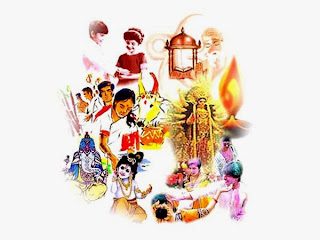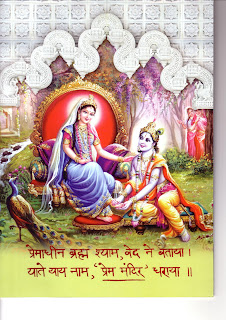Choosing a particular tradition, Guru & aspect of God
I'm unsure about how to choose a particular denomination in Hinduism.
How would someone new to Hinduism pick a particular tradition, Guru,
aspect of God, etc.? What influenced you to decide to worship Radha
Krishn and to follow Jagadguru Shree Kripaluji Maharaj?
The term we use in Hinduism for denomination is 'sampradaya', which means a lineage or tradition within Hinduism which was established by the followers of a particular Saint after he left the earth planet. The truth is that the original Master doesn't start the sampradaya. All Saints essentially teach the same thing: to surrender to God to receive His Grace and through His Grace attain Divine Bliss. This is the essence of Hinduism and the essence of the teachings of all true Saints in history. Internally all Saints are one; and essentially, their teachings are the same. However, the details of their explanations of the Hindu scriptures may appear to differ, but only on the surface. It is difficult (or impossible) for a material mind to reconcile these apparent differences, yet, essentially, all Saints taught the same thing: to surrender to God. A Saint may teach his followers a particular way of worshiping God which differs from what another Saint taught. But the reason for worshiping is the same: to become surrendered. So you see, the essence is the same, but the details differ. A Saint teaches the form of devotion which will be most helpful to those people at that time. Once he leaves, then people continue to follow his teachings, but what often happens is that they rigidly follow the outer formalities and forget that the real goal is to become surrendered. Thus, a sampradaya is born and is followed for many generations. Often the followers of different sampradayas bicker and criticize each other. They debate over the differences in the philosophical descriptions of their original Masters and argue about which form of worship is right. This is all a waste of time. Sampradayas are formed and eventually disappear. But the original teachings of Hinduism in the Vedas, Upnishads, Gita, Bhagwatam and other scriptures are eternal. And the original and eternal path to God (bhakti or surrender) is above differences in physical formalities of worship and above any sampradaya.
Swami Nikhilanand, JKP Radha Madhav Dham. © 2011. All rights reserved.
The term we use in Hinduism for denomination is 'sampradaya', which means a lineage or tradition within Hinduism which was established by the followers of a particular Saint after he left the earth planet. The truth is that the original Master doesn't start the sampradaya. All Saints essentially teach the same thing: to surrender to God to receive His Grace and through His Grace attain Divine Bliss. This is the essence of Hinduism and the essence of the teachings of all true Saints in history. Internally all Saints are one; and essentially, their teachings are the same. However, the details of their explanations of the Hindu scriptures may appear to differ, but only on the surface. It is difficult (or impossible) for a material mind to reconcile these apparent differences, yet, essentially, all Saints taught the same thing: to surrender to God. A Saint may teach his followers a particular way of worshiping God which differs from what another Saint taught. But the reason for worshiping is the same: to become surrendered. So you see, the essence is the same, but the details differ. A Saint teaches the form of devotion which will be most helpful to those people at that time. Once he leaves, then people continue to follow his teachings, but what often happens is that they rigidly follow the outer formalities and forget that the real goal is to become surrendered. Thus, a sampradaya is born and is followed for many generations. Often the followers of different sampradayas bicker and criticize each other. They debate over the differences in the philosophical descriptions of their original Masters and argue about which form of worship is right. This is all a waste of time. Sampradayas are formed and eventually disappear. But the original teachings of Hinduism in the Vedas, Upnishads, Gita, Bhagwatam and other scriptures are eternal. And the original and eternal path to God (bhakti or surrender) is above differences in physical formalities of worship and above any sampradaya.
Thus, you do not need to choose a sampradaya. However, you do need to choose a goal. Hinduism teaches that the search for happiness can be directed either towards maya
(the material world), or towards God. Those who direct their search
towards maya find disappointment because there is no lasting happiness
in the world. Those who direct their search towards God find perfect
happiness. But even those who direct their search towards God need to be
more specific in what their ultimate goal is. Why?
Because God has 3 main aspects, called bhagwan (loving God), parmatma (almighty God), and brahm (formless God). These are 3 aspects of one single God. The way to attain any of Them is the same: bhakti. Devotion to formless God is called gyan yog. Devotion to the personal form of God (either loving or almighty) is called bhakti yog.
In all cases, complete surrender to God to receive His Grace is
required. Those who ultimately attain formless God are freed from all
kinds of suffering forever, but then merge into formless God and remain
in a state of Divine peace which is unknown to them because they have no
body, mind or senses with which to experience. Those who attain
almighty God (Whose main forms are Vishnu, Shiv and Durga, and Whose
many affiliated forms include Ganesh, Lakchmi, Parvati, Saraswati,
Kartikeya, Kali, Gauri, Amba, and others) receive a Divine body, mind
and senses and go to the the Divine abode of their worshiped form of God
forever. There they experience unlimited Divine Bliss (included in this
is the release from all sorrows forever). Those who attain loving God
receive that, and more. What is more? They not only get to see God in
His Divine abode (like those who attain almighty God) but they get to
have close personal interaction with Him. The form of loving God is
Radha Krishn, Whose more reserved form is Sita Ram.
A Saint represents the
particular form of God which he has attained, and teaches devotion to
that particular form of God. This is why different Saints taught
devotion to different forms of God. It is a choice we need to make:
which form of God do we wish to attain? This choice is made based on
what Divine experience we wish to attain. Since we need the help of a
Saint to follow the path to God, choose a Saint who is teaching devotion
to that particular form of God you wish to attain.
So you see that you are not required to choose any particular sampradaya; but rather you choose to follow the guidance of a particular living Saint based on what your ultimate goal is.
I chose to follow devotion to
Radha Krishn because They are the most loving form of God Who award the
most intimate relation to the souls who surrender to Them. And I chose
to follow Jagadguru Shree Kripaluji Maharaj because he teaches devotion
to Radha Krishn and clarified what the goal is for me, as well as
teaching a simple and practical style of devotion.
Swami Nikhilanand, JKP Radha Madhav Dham. © 2011. All rights reserved.



Comments
Post a Comment